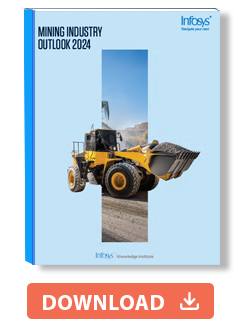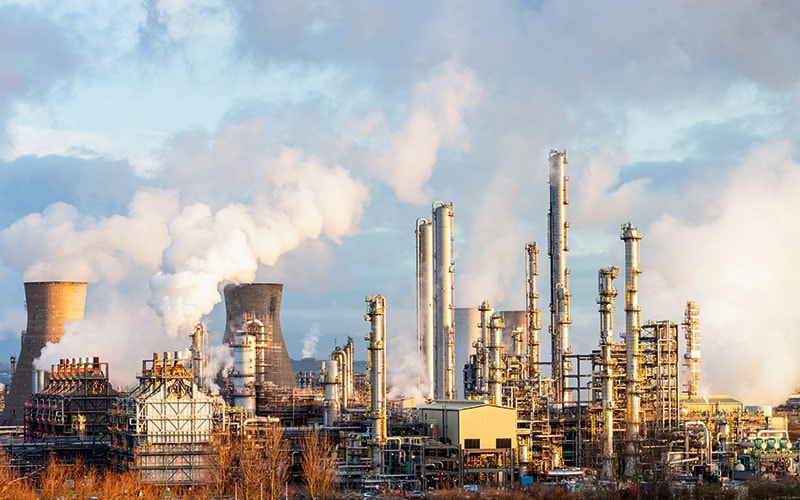Insights
- The mining industry powers the global economy with the building blocks of metals, minerals, and fossil fuels such as coal.
- Mining contributed 1.4% to the US GDP in 2023, yet casts a much longer shadow in its overall economic impact.
- The global mining market is expected to grow from $2 trillion in 2022 to $3.5 trillion by 2032 at a CAGR of 5.8%.
- There is a gap between what the world demands and what the mining companies can produce. Digital technologies will play a key role to plug the gap.
- Efficient, safe mining of critical materials is essential to satisfy demand, achieve energy transition goals, and meet net-zero carbon emissions.
- Companies that engage in physical mining and employ high levels of automation earn better profit margins due to lower operating costs and better, faster yield.
Executive summary
The mining industry powers the global economy with the building blocks of metals, minerals, and fossil fuels such as coal. Mining contributed 1.4% to the US GDP in 2023, yet casts a much longer shadow in its overall economic impact. Efficiently mining critical materials such as lithium, cobalt, and copper is now essential to satisfy current demand, achieve energy transition goals, and meet net-zero carbon emissions in multiple industries.
The global mining market is expected to grow from $2 trillion in 2022 to $3.5 trillion by 2032 at a CAGR of 5.8%. But there is a gap between what the world demands and what the mining companies can produce. For example, green initiatives like battery production need vast quantities of lithium, cobalt, and copper. However, by 2030, existing mines will produce only about half of the lithium and cobalt and around 80% of the copper required.
Meanwhile, there is increasing focus on circularity at the end of the product life cycle to reuse, recycle, or refurbish parts and materials, reducing demand for virgin resources. Manufacturers must now report the proportion of virgin materials compared to recycled product content. Additionally, mining for battery raw materials may peak by 2030s due to recycling efforts.
Given these dynamics, four business trends in the mining sector have emerged: sustainable energy transition from supply of critical materials and decarbonization; operational efficiency for better yield with cheaper, faster workflows; supply chain resiliency to spring back from unforeseen disruptions; and safe and socially responsible operations.
Technologies driving these trends are artificial intelligence (AI) for automation and autonomous decision-making; industrial internet of things (IoT) with IT-OT integration for enhanced visibility from the top floor of the enterprise to the mines; 5G for real-time communication; and fog computing for local decision-making between data sources like IoT at the edge with central cloud systems.
The mining industry powers the global economy with the building blocks of metals, minerals, and fossil fuels such as coal.
Market dynamics
Market dynamics are an outside-in perspective for mining companies, enabling to benchmark best practices and lessons learned, including from beyond mining. Figure 1 highlights leading mining companies by market capitalization.
Revenue vs. profitability
Companies that engage in physical mining and employ high levels of automation earn better profit margins due to lower operating costs and better, faster yield (Figure 2). A plot of annual revenue versus EBITDA margins for mining companies gives a bird’s eye view of how large players perform. Glencore, despite a revenue of $217 billion, has a single-digit profit margin since it is also into commodity trading, a low margin business.
BHP’s Spence copper mine in Chile is fully autonomous, a transition that began in 2022. This shift is expected to reduce risk exposure in mining operations by 90%. Rio Tinto has a fleet of 130 autonomous trucks for haulage in its iron ore mining operation. The trucks delivered a 15% cost savings, increased productivity, and prevented humans from working in unsafe conditions. Other miners are also investing in automation and autonomous decision-making to improve efficiency.
Strategic changes
Traditional mining companies face challenges to keep pace with growing demand for critical materials. Organic growth is a long business cycle in mining. Traditional mining sectors operate slower than fast-moving, competitive critical materials businesses, where quick decisions are necessary. Critical materials need to follow and catch up with trends like electrification, renewable energy, and energy transition. These conditions have led to and will continue to see mergers, acquisitions, business consolidations, and carving out critical material business. For example, Rio Tinto acquired Turquoise Hill in 2022 to strengthen its copper portfolio, and BHP completed its acquisition of OZ Minerals in 2023 to expand its portfolio in copper and nickel.
Companies that engage in physical mining with automation earn higher profit margins due to low operating costs and better, faster yield.
Figure 1. Top 10 mining companies by market value, Q2 2024 ($ billions)
Source: Mining.com
Figure 2. Revenue vs. profit margins for top 15 revenue-earning mining companies, 2023
Source: Refinitiv
Potential risks to growth
Regulatory compliance
Mining companies must navigate complex regulatory environments that vary by country. Changes in laws related to environmental protection, labor rights, and land use often impose additional costs and operational delays. Noncompliance activity risks fines, legal actions, and reputational damage.
Resource nationalism has gained momentum as countries seek to retain more benefits from their natural resources. Governments in Africa and South America are increasing taxes and imposing stricter regulations on foreign mining companies. In Asia, Indonesia has banned the export of unprocessed nickel, pushing companies to invest in local processing facilities.
Environmental concerns
Mining activities can lead to significant environmental degradation, including habitat destruction, water pollution, and carbon emissions. Increasing scrutiny from governments and communities demands companies to adopt sustainable practices, often requiring costly investments in mitigation technologies.
The Democratic Republic of the Congo (DRC) accounts for more than 50% of the global cobalt reserves. In the Gécamines neighborhood in Kolwezi city in DRC, 40% of the land became a copper and cobalt mine in 2022. The area was home to 39,000 people, and their relocation became controversial.
As geopolitical risks, mining operations are vulnerable to geopolitical tensions, trade disputes, and changes in government policies. Such factors can disrupt operations, lead to expropriations, and create instability in mining regions.
Although the DRC classifies mining as hazardous child labor, children continue to work in the informal mining sector. Projects like Combatting Child Labor in the Democratic Republic of the Congo’s Cobalt Industry (COTECCO) aim to improve working conditions in DRC’s mines and reduce child labor. Human rights organizations have filed lawsuits against large corporations, making it a tricky issue for them whether to continue with DRC. Cobalt, commonly used in battery cathodes for its high energy density and thermal stability, requires alternative sources, mining methods, or substitute materials to avoid these challenges.
The mining industry relies on complex supply chains for equipment, materials, and labor. Disruptions due to geopolitical tensions, natural disasters, or pandemics can lead to project delays and increased costs.
Supply chain disruptions such as the Suez Canal blockage, floods in China in 2021, and labor unrest in Chile and Peru in 2023 impacted the mining industry, beyond the pandemic and conflicts between countries. Mining companies took precautionary steps such as supply chain diversification, localization, and transparency to mitigate such risks in future. Supply chains are becoming shorter by identifying alternate suppliers closer to the customer. In the area of market volatility, commodity prices are highly volatile due to global economic conditions, demand fluctuations, and geopolitical tensions. This unpredictability complicates financial planning and investment strategies for mining companies.
Social licenses to operate are an important consideration. Gaining and maintaining community support is essential for mining operations. Displacement of communities, land rights conflicts, and inadequate engagement frequently spark opposition and protests, jeopardizing projects and operations. The Porgera gold mine in Papua New Guinea, once responsible for around 10% of the country’s exports, has stalled production due to tribal violence triggered by displacement.
Operational dynamics
The broad operational trends in the mining industry are sustainable mining for energy transition, operations efficiency that includes workforce skill development, safe and socially responsible mining, and supply chain resilience (Figure 3).
Figure 3. The four broad business trends in the mining sector
Source: Infosys
Safety, social responsibility
Mining has always been one of the most dangerous industries, although safety measures have improved outcomes significantly. In the US, fatal injuries in the mining, quarrying, and oil and gas extraction sectors have decreased to below 100 in 2020. Safety remains paramount as mining expands into hazardous environments due to resource depletion driven by growing demand and overconsumption. This leads to new exploration, projects, exploitation, and unsustainable mining practices. Companies are leveraging technology to enhance worker safety, including wearable devices that monitor health metrics in real time, personal protective equipment, training of miners to use safety equipment, sensors, and associated technologies to sense dangerous gases, and emergency response planning.
Sustainable mining for energy transition
The mining sector accounts for between 2% and 3% of global carbon emissions, and mining companies have announced initiatives to achieve net-zero carbon emissions. The industry is focused on sustainability, driven by environmental regulations and social responsibility. Companies are adopting green technologies such as electric vehicles and renewable energy sources to minimize their carbon footprint. For example, Rio Tinto aims for net-zero emissions by 2050 and has initiated solar and wind projects to power operations. The industry also prioritizes responsible sourcing of materials like lithium and cobalt for batteries, emphasizing reduced habitat destruction. This trend reflects a growing demand for eco-friendly practices in mining.
Operations efficiency
Overall equipment effectiveness (OEE) assesses the effectiveness of industrial equipment, considering equipment availability (uptime), performance (measured by output speed), and quality. OEE is used in the mining industry to measure effectiveness of heavy equipment. OEE is improved by steps beyond digitization and automation such as ore quality improvement and fragmentation.
As the industry faces a skills gap, investment in workforce development is crucial. Mining companies emphasize training programs to equip workers with the necessary skills for a technologically advanced environment. Estimates suggest that decarbonization could lead to job losses of up to 154,000 in the coal mining industry by 2030, specifically in the European Union. Globally, 4.7 million jobs exist in coal mining in 2022, with a job loss of one-third due to mechanization between 2008 and 2019.
At the same time, investments are being made in renewable energy, while some employees are retrained to shift to roles in the renewable industry. In the European Union, job demand in the renewable energy sector is expected to grow by 304,000 new jobs per year until 2030, with 60% of these jobs expected in the wind sector and 24% in the solar sector. For 71% of mining leaders, talent shortage is holding them back from achieving their production targets and strategic objectives.
Supply chain resilience
Business disruptions such as the Covid-19 pandemic have nudged corporates to move beyond faster, cheaper, better products, to resilient and on-time supply to their customers. RISE (Resilient and Inclusive Supply Chain Enhancement) is a global initiative for diversified, sustainable, resilient supply chains, specifically for the critical metals required for energy transition. By 2040, the global demand for critical minerals for renewables, mobility electrification, and industrial process decarbonization is estimated to be four times the current demand of $325 billion. Japan and the World Bank announced the initiative in 2023, with Canada, Italy, the Republic of Korea, and the UK as donors, and more countries are expected to join.
The three pillars of RISE are regional analytics to identify challenges and opportunities, technical assistance for skill development, policy design, capacity building, strategic investment planning, and investment facilitation. Expected outcomes include investments in strategic infrastructure and mineral value chain, skilled workforce, and regulations for manufacturing. The infrastructure includes both hard (IoT for data gathering, communication channels) and soft (analytical models for decision-making) investments.
Supply chain transparency is a proactive measure of resilience. Technologies such as IoT, GPS (global positioning systems), cloud, and blockchain enable tracking a shipment from its origin to its destination, raising alarms in case of any disruption. Blockchain helps companies like BHP answer questions about the environmental footprint of their supply chains, whether materials are ethically sourced, and the value realized from shipments.
Technology trends
Crucial mining sector technologies are IoT for parameter measurement, integrated with the rest of the enterprise; 5G to communicate important data; fog and edge computing for rapid and localized decision-making; and centralized AI and automation for autonomous decision-making (Figure 4).
Figure 4. Technology trends that drive the mining sector
Source: Infosys
Digital technologies enhance efficiency and safety at each stage of the mining value chain.
AI and automation
Digital technologies enhance efficiency and safety at each stage of the mining value chain. Adoption of automation, including fully autonomous mining operations with vehicles and drones, streamlines processes and reduces worker risks. AI and autonomous systems are crucial to improve yield, address workforce shortages, and enable timely decisions without human intervention, leading to safer, more productive operations.
Nutrien has deployed tele-remote technology to address high-risk activities such as ground falls in underground potash mining. Autonomous mining is carried out from remote locations, eliminating humans from hazardous situations.
AI and machine learning (ML) analyze vast amounts of data to optimize operations, from exploration to production, throughout a mine’s life cycle (Figure 5). These technologies identify patterns and provide predictive analytics for better planning and decision-making.
Figure 5. Use cases for AI at every stage in the life cycle of mines
Source: Infosys
The major AI use cases by life cycle stage in mining are:
Exploration: This stage is risky, with less than 1% of projects progressing to the establishment of a mine. Gold production company Goldcorp uses AI to determine optimal drilling locations by analyzing geological data with deep learning to identify hidden gold deposits. Vale uses deep learning algorithms to analyze satellite imagery for environmental monitoring and exploration. However, the long discovery-to-production cycle time in mining, averaging more than 15 years, and the rarity of successful discoveries make it difficult to gather data for successful AI deployment.
Setup and planning: Vale’s AI center was setup for AI initiatives in business units across countries. One project was for train wheelset maintenance using sensors, to measure the temperature and noise of bearing, wear of wheels, and bogie displacement. This information helped plan the maintenance and purchase of assets and extend their useful life. In its first year, the program generated $400,000 savings — 10 times its cost.
Development: BHP uses sensors in hard hats to analyze brain waves and measure fatigue in truck drivers. This arrangement can avoid accidents resulting from driver drowsiness.
Production: Freeport-McMoRan faced a dilemma in increasing its production — whether to invest and open new mines, or to improve operations and increase production from its already mature mines. Freeport decided to go the AI way and built a central cloud-based data architecture to capture minute aspects of mining operation. This data trained AI models to pinpoint opportunities for production enhancement, resulting in a boost of 5% to 10% in output.
Industry-specific use cases allow businesses to embed the nuances of sector-specific AI solutions to address unique challenges and opportunities. Infosys Topaz uses generative AI to deliver value through such applications.
Private 5G networks for communication
5G's properties (low latency, better bandwidth, low physical footprint, and reliability) make the technology suitable for remote mining operations. Mining, especially with automation, needs continuous equipment operation and monitoring for productivity and safety. For example, the Swedish mining company Boliden implemented 5G in its underground mine. The network functions locally and ensures functionality even when it loses external communication. The Yanjiahe Coal Mine in China uses a 5G private network and edge computing to boost efficiency and improve safety in its major mining operations.
Industrial IoT and IT-OT integration
Mining operations should be integrated with the rest of the enterprise to enhance efficiency and remain attuned to market dynamics and customer needs. The integration of OT applications such as MES and SCADA with enterprise applications including ERP and CRM is essential to streamline key processes, including geological modeling, mine planning, materials management, logistics, and finance. This ensures smooth communication and efficiency across all aspects of mining operations.
Thomas Leen, chief security officer at BHP, explained how IT-OT convergence is as much a cultural challenge as a technical one. In the traditional IT mindset, there is a tool or an application for every challenge, and a focus on standard processes, optimizing them from a cost and agility perspective.
However, engineers in the OT world tend to focus on processes for system reliability and people safety. These two perspectives need to merge and share best practices with each other. The evolving convergence of IT and OT networks introduces new cyber risks, as traditional IT networks prioritize service availability for the enterprise. BHP and Rio Tinto had to boost their cybersecurity resources to address the technology challenges posed by this convergence.
Fog computing moves closer to the edge
Companies increasingly look to cloud computing to modernize and grow. Cloud helps them access emerging technologies that facilitate new revenue streams, business models, and integration of acquisitions. However, mines operate in remote locations and deep under the surface, challenging network connectivity. To overcome this, mining companies are adopting fog computing, which links IoT sensors at the edge with centralized cloud systems, allowing local processing without constant enterprise-level network connectivity.
Boliden tried sensors to monitor its mines, the stability of its wells inside them, and mining operations. However, they were expensive, needed high maintenance, and were difficult to automate.
The mining company went for a network of 500 cameras, creating a strenuous, nonproductive task for humans to continuously monitor the video feed. Instead, it used edge computing with ML to integrate the camera feed with other sensor inputs and monitor the mines.
Following the success of cameras with local decision-making, Boliden wanted to add gas measurements, vibration sensors, and more such data sources to its edge computing setup. Vibration measurement and new bearings at its Aitik copper mine increased availability and avoided unplanned stoppages in the seven-kilometer-long conveyor belt.
Recommendations for sustainable, safe mining
Based on emerging technology trends and ongoing developments in the mining industry, we recommend the following for sustainable and safe operations:
Collaboration: Industry players, governments, and local communities must collaborate to share knowledge, resources, and technology to address challenges like resource scarcity and environmental impact. Companies are forming alliances with mining automation solution providers to develop shared infrastructure for mining operations. Collaborative efforts also include engaging local communities in decision-making processes. Komatsu for example provides mining automation solutions beyond just autonomous trucks to include automated drilling and identification and rectification of maintenance and safety issues.
Material circularity: Mining companies should proactively plan and invest in circularity, focusing on reverse logistics of end-of-life materials. This involves transporting valuable material back to manufacturers for reuse. Technologies to separate reusable materials from scrap are essential to facilitate circularity.
Local decision-making: Mining is a risky business that needs quick decisions for safety and cost control. Communication with a central chain of command is a challenge due to the remote nature of operations in mines in hazardous terrains. Investment in local decision-making with technologies such as IIoT, edge, and fog computing, and AI/ML for autonomy are important for quick decision-making avoiding any time lags in communication, analysis, and action.











